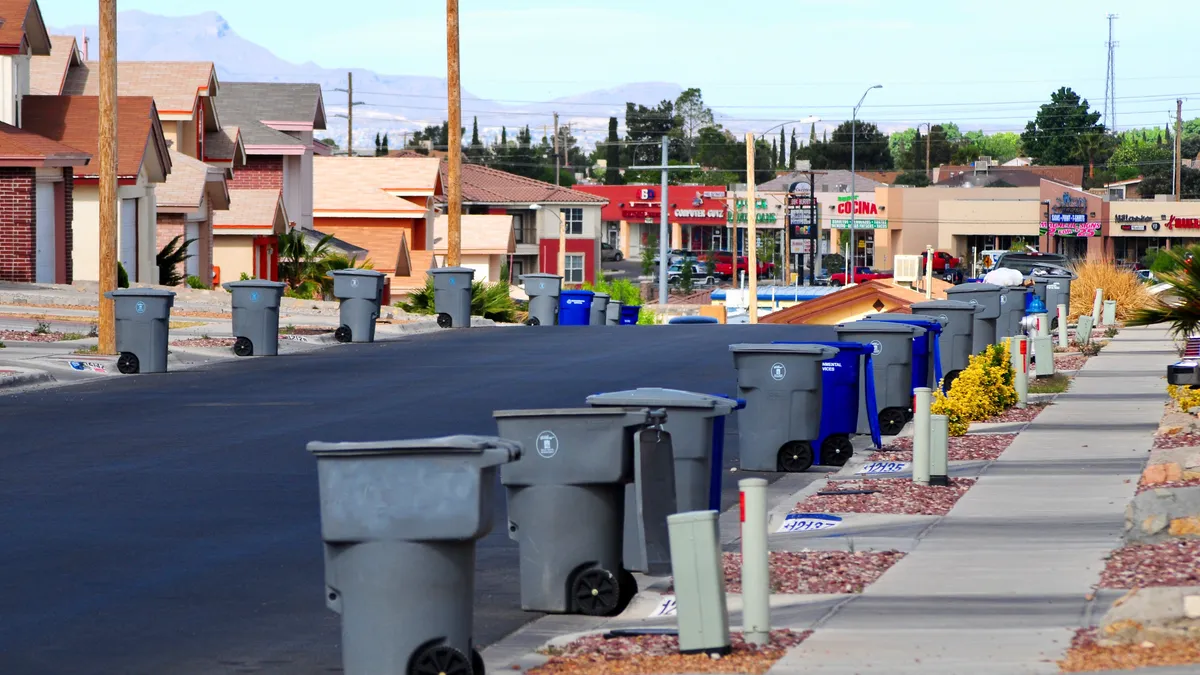Dive Brief:
- Injury and illnesses increased to a rate of 5.5 incidents per 100 full-time employees for waste and recycling collection workers in 2018, according to the Bureau of Labor Statistics (BLS). That is nearly double the national rate of 2.8 for all occupations, which held steady over 2017.
- Solid waste collection workers specifically saw an increase from 5.1 to 5.9. The rate of cases with days away from work was 4.3, with incidents resulting in a median 13 days away from the job. Throughout the occupation, "sprains, strains and tears" were most often cited as a rationale, while vehicles were the most common source of injury.
- But two categories that saw incidence rates increase in 2017 declined in 2018, including landfills, which went from 5.3 to 3.9. For MRFs, injury and illness rates also declined from 9.8 to 4.9. Rates for the "solid waste combustors and incinerators" category, historically among the lowest, were not available because data didn't meet BLS publication criteria.
Dive Insight:
According to BLS, 2.8 million nonfatal injuries and illnesses were reported by employers in 2018, the same as 2017. This notably marked the first year since 2012 where the incidence rate for total recordable cases in private industry didn't decline. The incidence rate for the overall "waste management and remediation services" category, which includes hazardous waste and other areas, also stayed level at 4.2.
That increase in injury and illness rates in the collection sector comes amid ongoing concerns about route safety, which persist given the inherent, unpredictable hazards of repeatedly picking up carts or bags, as well as dealing with third-party distracted driving. This trend was also cited as a source of concern by the Solid Waste Association of North America (SWANA) and National Waste & Recycling Association (NWRA).
"The increase in the collection injury and illness rate reported by BLS for 2018 parallels SWANA’s data that showed an increase in solid waste employee collection fatalities last year. For a variety of reasons, 2018 was not a good year for the collection side of the industry from a safety perspective," wrote CEO David Biderman in an email to Waste Dive. "We are pleased by the substantial decline in the incident rate for landfill employees, which is now at its lowest level since 2015.”
While the landfill results follow a more logical progression, the spike in MRF data between 2016 and 2018 makes it harder to draw clear conclusions for that category. Last year's incidence rate of 9.8 was among the highest for any occupation in the country, but BLS has described the shifts as not statistically significant. The change for collection workers, however, is notable and indicates efforts to pass Slow Down to Get Around laws and other educational initiatives may only be part of the solution.
“The decrease at landfills and MRFs is promising, but today’s numbers show that we have yet to make real progress out on the roads where our collections workers face numerous hazards on a daily basis. We need to redouble our efforts and make sure that we are doing all that we can to protect our employees. The numbers today demonstrate that we have serious challenges ahead,” said NWRA CEO Darrell Smith in a statement.
One development industry safety professionals are intrigued by is the recently signed alliance between SWANA, NWRA and the federal Occupational Safety and Health Administration (OSHA). A similar alliance between the Institute of Scrap Recycling Industries and OSHA has so far been received positively within the space.
Other ongoing initiatives include SWANA's Hauler Safety Outreach events, designed to reach public and private sector operators of all sizes. In an effort to gather more precise safety data, given the potential limitations of BLS industry classifications, NWRA has also partnered with the Environmental Research and Education Foundation to conduct new research. SWANA's own data tracking indicates the even bigger metric – fatality rates – may be similarly high for 2018, but could be reversing course.
“Data collected by SWANA so far in 2019 indicates that the frequency of fatal incidents has declined a bit compared to 2018, and we are hopeful this trend will continue for the remainder of 2019 and into 2020," said Biderman.
BLS is expected to release 2018 fatality data on Dec. 17.














